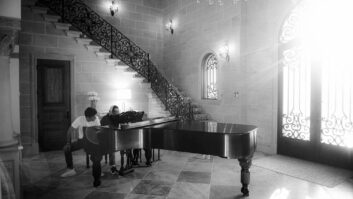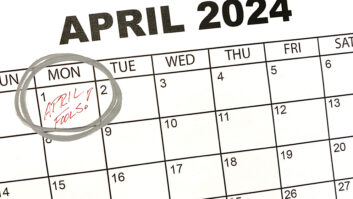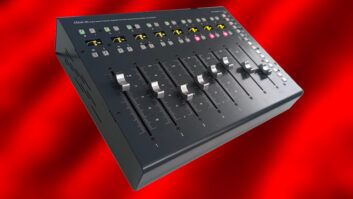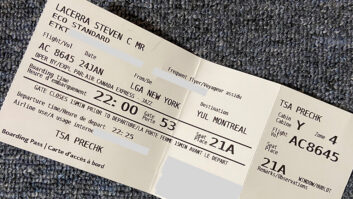Every month, we at Mix and Mix Online get hundreds of e-mails andforum questions about how to do stuff: mike a drum kit, get into aschool, get out of a school, get a record contract, get out of a recordcontract, achieve the sound that some well-known group has on theirlatest album or handle an annoying client. Usually we try diligently toanswer these questions ourselves or refer the questioner to someonemore qualified. This month, we are very pleased that my old buddyPhineas T. Grumpmeier, Lit.D., Pd.Q, L.S./MfT, now on the faculty ofthe Department of Misapplied Audio at the Southeast HackensackInstitute of Technology, has agreed to lend us his impressive expertiseand respond to some of our typical questions. Over to you, ProfessorGrump…
What’s the best computer for doing audio editing?
We all know the problems that both Macintosh and Windows machineshave, and although things have gotten a bit more stable recently, Istill don’t trust either of them. I also don’t think much of the factthat, because there’s no way to move session files between them or evenbetween most applications on the same platform, then whatever you getnow you’re going to be stuck with forever — unless, of course,whenever there’s any kind of update, you’re happy to convert everythingyou’ve ever done throughout your entire career into a new format.
That’s why I use a 1982 BBC Acorn for all my audio editing. I get 38seconds of 8-bit, 6kHz audio on each 5.5-inch floppy disk — butyou know, what goes around, comes around. And, as it happens, it’s justperfect for Web work. The disks are dirt cheap, if you can find them,which I sometimes can in flea markets and on eBay, although dumpstersbehind office buildings are a more reliable source. But the best partis that I don’t have to worry about those silly hardware or softwareupdates, because I know darn well there aren’t going to be any.
I’m building a studio in my parents’ garage. I have a lot ofexperience doing live sound for solo acts at open-mic Mondays at alocal club and hanging around with the DJs the rest of the week, and Iwork days at a video store where I get to watch a lot of TV. So I’mpositive I’m ready to move up to the next step and record major labelacts and score Hollywood feature films.
I know that the gear isn’t as important as how well you use it, and Ithink mine is good enough: I’ve got an 8-track cassette recorder inpretty good shape, a couple of microphones with the model and serialnumbers scratched off (they’re black and have a round ball at the end,if that helps) and some kind of mixer I found at a yard sale, whichstill has most of the knobs.
I also have a pile of old 2×4s and some slightly used sheetrockbehind the house and a couple thousand empty egg cartons (my folks owna chicken farm), which I know will come in handy.
What else do I need to buy, and where can I go on the Web to get freeadvice about design, acoustics, wiring, equipment, and recording andmixing techniques? I need to keep my total budget under $500.
It sounds to me like you’ve got all that you need to go head-to-headwith the big studios. Their stuff may be flashier and more expensive,but that doesn’t mean it works any better — if it did, why wouldthey need to keep full-time technical staff around?
As for information about how to build your studio and how to producerecords and film scores, there are dozens of acoustical consultants,designers, composers, producers, and recording and mixing engineers whohave posted everything they know on the Web, and it’s yours for thetaking. After all, they’ve already made their money, so now they’rehappy to give their knowledge away to anyone who wants it.
Just go to your favorite search engine, type in “How to make ahit record” and you’ll be directed to thousands of great sites,some of which will also feature surefire ways of making $10,000 a weekin only five minutes a day, while others will have grainy pictures ofmen, women and animals in truly remarkable poses. Best of luck to you.Just make sure those egg cartons are clean.
My favorite grunge-metal band is the P*gf*c*ers. They rule. Theirlead singer, Nolo Vox, does this really cool thing on their tune“P*ss on Y*u B*t*h,” in which it sounds like he’s throwingup into a trash can. I want to get a similar effect on my band’s nextrecord. How did they pull off that amazing sound?
I checked with their producer, the London Conservatory-trainedTrevor Trevor III. He told me, “We did most of the album at astudio in Hollywood, but for that one track, we rented a manor house inthe Cotswolds for a week. We sent all the servants away except for theFrench cook and brought in three Sony digital 48-tracks, a 92-inputEuphonix board, a trunk full of Neumann, AKG, Sennheiser and B&Kmics and 16 channels of Millennia preamps, and we wired the banquethall with big Tannoys in a 7.1 configuration.
“We tried recording Nolo in every one of the 52 rooms, puttinghim in different corners, on top of and underneath various pieces ofthe Louis XIV furniture, and setting the mics up in X-Y-, M-S-, ORTF-and B-format Ambisonic. We filled about 20 reels of tape, but I wasn’thappy with anything we had.
“Finally, at around midnight, the last night we were there,after a dinner of frog’s legs, octopus, blood pudding and trifle, Nolosuddenly said he wasn’t feeling too well and ran out of the diningroom. He didn’t make it to the lavatory, but he did get as far as alarge metal drum that was sitting in the hallway that had been filledwith — um, uhh — sugar. As luck would have it, one of myassistants had accidentally dropped a Shure wireless mic into the drumearlier that day, and it was still on. So when Nolo blew his cookiesinto it, we had a clear signal right to tape. It was a wonderfulmoment, one that would be hard to reproduce, I’m sure.”
I need to find a good audio engineering school. I’m not sure whatI want to do, but I love music and want to make it my career. It’s gotto offer guaranteed job placement in a professional situation, ascholarship, free room and board and not take longer than six weeks.And it shouldn’t require a high school diploma. Also, it has to be nearmy home in Bemidji, Minn., so I can report to my parole officer everyFriday. What’s the best school that fits these criteria within a fewhours’ drive from me?
A quick look at the Mix Audio Education Directory shows that theGlobal Engineering and Technical Repository for Education and AudioLearning (GETREAL) has a brand-new campus, their 93rd, not far from youin Hibbing, above the hardware store. (The door’s off the alley, knocktwice.) They have six SSL rooms, four Mackie rooms, two Avid suites anda soundstage large enough for a 70-piece orchestra. Their programsrange from one week to three months — the longer programs alsoinclude everything there is to know about video and Web design.
They will help you find a job, although you may have to accept anunbreakable lifetime contract as a washroom attendant at a theme park,with the possibility of promotion to assistant post-parade sweeperafter five to eight years. Tuition is very reasonable, and room, boardand snowshoes are included. My sources tell me, however, that they arehaving a little difficulty attracting faculty.
I know that to make digital tracks sound “warmer” Ineed a good tube mic preamp. What’s your favorite?
The best preamp I’ve come across is a totally discrete module takenfrom a 40-year-old RCA broadcast console, hand-remanufactured withoxygen-free silver wire and NASA-spec resistors by members of ananimist motorcycle cult living on a Connecticut Indian reservation. Ituses a matched pair of Nuvistor pentodes, whose numbers are stillconsidered classified, and are today only made by Russian emigrémonks in a small factory in Hokkaido on the second Thursday ofalternate months. The waiting list for these units is about two years,while the tube makers are more like five years behind.
Everything else out there sucks.
I have a Mac G4 running Pro Tools 5.1 and Cubase VST, using dual888 interfaces, a MOTU Digital Timepiece, Aardvark format converters,an Opcode Studio 5, and a Horita blackburst and timecode generator. MyMIDI rig is a Kurzweil K2600R, a Roland S-760 and a Korg Triton, allwith digital outputs. My microphones run through JoeMeek preamps andApogee 24-bit convertors, and then everything goes into a Yamaha 02R,configured for 5.1, and out to an Event digital surround speaker systemand a Tascam DA-98HR. I also have a Panasonic DVCAM deck feeding a500MHz Pentium 4 through FireWire, running Edit DV and Vegas Pro underWindows 2000 with a Layla card and a SoundBlaster Live.
My problem is I can’t get anything to sync to anything else. Whenever Iturn on more than two devices, one of them starts flashing “WordClock Error,” and this horrible high-level burst of noise fillsthe room and sends me screaming out the door. It’s very tough to figureout what’s going on under these conditions. I’ve already blown threemidrange coils, and my doctor tells me I’ll have to stop soon before Isuffer from major hearing loss, a nervous breakdown or both. Meanwhile,I’m working on a prime-time network production that goes on the air in10 days, so I’m desperate for your help.
Why does this have to be so darn complicated? I have no idea whatshould be the master, and what should slave to what, and how to get theclocks and sampling rates to agree with each other. None of the techsupport people at the companies have a clue. Why can’t manufacturerscome up with some standard way of dealing with external sync? Or is itjust me?
You’re right — it’s just you.
What’s your favorite plug-in?
That would be “Speaker Maker” from a small company inUzbekistan called “Grzsnykolpfbimt PLG,” which, roughlytranslated, means, “Even lower than wholesale.” It can makeany speaker you’ve got sound like any speaker you could ever want: Youcan turn a pair of Genelecs into NS-10s, or vice versa. I like to useit with the little Radio Shack mini-monitors sitting on my console,making them sound like Westlake 5s with a sub-subwoofer. The effect isuncanny. The 119 dB of boost required at 45 Hz makes the things alittle warm, but a couple of inches of asbestos underneath them keepsthem from melting through the meter bridge.
What’s the best microphone for vocals?
I like the Astrovox 466, which we used to like to call “TheHackensack Hammer.” That’s because it was made right here inHackensack, N.J., and you could bang nails into the floor with it andthen sing into it, and it would sound just the same. It’s also usefulfor pitch-correction: If your vocalist starts to go flat, then you canhit him upside the head with it and he’ll straighten right out. It’sgot a huge proximity effect that’s perfect for those “voice ofdeath” goth-metal tracks.
You can be sure that nobody will ever steal it, because it has a weirdo7-pin connector that doesn’t match anything else in the known universe.Best of all, the pop screen is electrically live, which discouragesspitting and is useful for disciplining an egomaniacal guitar player:If you set up the polarity on his amp right, when he leans forward tosing, it’ll fry his moustache right off.
Of course, it sounds awful, but who cares about that?
What’s the best way to equip my studio for surround?
It depends on what you’re surrounded by. If you’re planning onrecording lots of rap and you are surrounded by hostile neighbors, thenI would recommend a high-voltage electric fence. Make sure there areplenty of warning signs to keep lawsuits at a minimum. If your studiois out in the woods and you’re worried about the birds and porcupinesmaking too much noise, then a small-bore automatic pistol can be veryuseful. And if you’re recording Christina Aguilera or Britney Spears,and figure on being surrounded by screaming teenage girls, then a fewcattle prods and cans of Mace are an excellent investment.
My PC-based DAW says that it handles 24-bit audio, but when Iburn a CD, it’s only 16-bits. What happens to the other eightbits?
The other eight bits are still on the CD, but they’re in a speciallocked file that can only be opened by members of an exclusive recordindustry organization, the Society for Music Decoding andInterpolation, or “SMDI.” Should your CD ever be acquiredby a record label that is a member of this powerful but very secretivegroup, they will be able to recover the extra bits when they reissueit, after your copyright expires, as a 24-bit DVD-A. This ensures thattheir catalog will never go out of date, but, of course, it doesnothing for you.
i wanna be a audio engineer and do dejay stuf too. do you now anygood books or softwears that can hep me lern!?
Start with Travis Bratwurst Teaches Typing. Then check out SpellChecking for Blithering Idiots, and when you feel you’ve masteredthose, you’ll be ready for Where the Heck is the Shift Key, Anyway?
After 20 years in computer systems engineering, I want to getback to my first love, which is recording and playing music. But I feellike I’ve missed out on so much that I need to catch up on: digitalrecording, DSP, synchronization, MIDI, DAWs, automated mixing, Webstreaming and so on. Also, I’m very troubled by Napster and MP3 andwhat they mean for the music industry. If everything is available forfree, then who’s going to pay the musicians? I don’t want to spend alot of time learning all this new stuff and trying to make a career ofit, and then find out I’ll never get paid.
What would be your advice for the best place to go to study everythingI need to know to get up to speed on all the important new issues inthe recording field and also to get the skills to be able to continueto make a decent living in it?
Two words: Law School.
Paul D. Lehrman apologizes for taking the month off.






